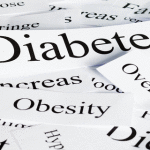 It’s not uncommon to have diabetes and yet have no symptoms. Type two diabetes in particular, develops slowly- over many years.
It’s not uncommon to have diabetes and yet have no symptoms. Type two diabetes in particular, develops slowly- over many years.
The good news is that many people with diabetes who are overweight can improve their glucose levels simply by losing weight. Even a small loss can be beneficial.
What are the Risk Factors for Diabetes?
Although it’s not fully understand why some people get diabetes and others don’t, it’s clear that certain factors increase your risk. These factors include:
Family history: Your chance of developing type 1 or type 2 diabetes increases if you have a close relative, such as a parent or sibling, with the disease.
Weight: Being overweight is one of the main risk factors for diabetes — 8 out of 10 people with type 2 diabetes are overweight. That’s because the more fatty tissue you have, the more resistant your cells become to your own insulin. In fact, the link between obesity and diabetes may lie in what researchers are calling resistin, a hormone discovered in mice that makes cells resistant to insulin.
Still, it’s not just a matter of how much you weigh — It also depends on how the weight is distributed. If you have extra weight in the upper part of your body — particularly around your abdomen (apple-shaped) — you’re especially at risk. In addition, women who gain even moderate amounts of weight — 10 to 20 pounds — as young adults are at higher risk of gestational diabetes.
The good news is that many people with diabetes who are overweight can improve their glucose levels simply by losing weight. Even a small loss can be beneficial.
Inactivity: The less active you are, the greater your risk of developing diabetes. Physical activity helps you control your weight, uses up glucose, makes your cells more sensitive to insulin, increases blood flow and improves circulation in even the smallest blood vessels.
Exercise also helps build muscle mass. That’s important because most of the glucose in your blood is absorbed into your muscles. When you have less muscle tissue, more sugar stays in your blood.
Age: Your risk of developing type 2 diabetes increases as you get older — especially past the age of 45. Often, that’s because people tend to exercise less, lose muscle mass and gain weight as they age. But diabetes is also increasing dramatically among younger people — especially those in their 30s and 40s.
Race: For reasons that aren’t entirely clear, people of some races are more likely to develop diabetes. Approximately 6 percent of the general population has diagnosed diabetes. But that rate doubles for blacks and Hispanics and more than doubles for American Indians.
Among the Pima Indians, half of all adults have type 2 diabetes — one of the highest rates of diabetes in the world. Type 1 diabetes, on the other hand, is more common in Caucasians and in European countries such as Finland and Sweden.
Sleep: Both too little and too much sleep could increase your risk of type 2 diabetes. Studies have found that those getting less than six or more than eight hours of sleep a night had a significantly increased diabetes risk.
The risk was roughly twice as high for those sleeping relatively short periods, and more than three times as high for those who slept for long periods. Those who slept for seven to eight hours a night were at the least risk.
The Benefits of Vedic Meditation to Manage and Prevent the Symptoms of Diabetes:
The regular practice of the Vedic Meditation technique creates a deep state of physiological rest which dissolves stress and allows the natural regeneration processes of the mind and body to restore balance to the system.
As a result, major risk factors of disease such as cholesterol, smoking, alcohol consumption, and stress are reduced.
The Benefits of Vedic Meditation Include:
- Reduced Cholesterol
- Reduced Anxiety
- Reduced Cigarette Smoking
- Reduced Alcohol Consumption
Related Topics:
Physical Activity Can Improve Cholesterol Levels
Physical activity can improve cholesterol levels, help control high blood pressure and diabetes, and manage weight. It also increases physical fitness, promotes psychological well-being and self-esteem, and reduces depression and anxiety.
Benefits of Weight Loss
Being overweight is a risk factor for health problems such as diabetes …
Choose Foods Low in Cholesterol
For some people it is necessary to combine cholesterol lowering medications with changes in life habits to get enough of a reduction in cholesterol.
 How many times have you gone to sleep at night, swearing you’ll go to the gym in the morning, and then changing your mind just eight hours later because when you get up, you don’t feel like exercising?
How many times have you gone to sleep at night, swearing you’ll go to the gym in the morning, and then changing your mind just eight hours later because when you get up, you don’t feel like exercising?
It’s time to start a Healthy life: your 7 days program
 … the combination of Vedic Meditation, for twenty minutes twice a day, with a good diet – especially a low fat, low salt diet – and physical exercise, should see a dramatic change in your health.
… the combination of Vedic Meditation, for twenty minutes twice a day, with a good diet – especially a low fat, low salt diet – and physical exercise, should see a dramatic change in your health.
Vedic Meditation is one of the most powerful techniques available for reducing stress and anxiety. It is also one of the easiest to learn and simplest to practice.
If you are in Auckland (NZ) call me, Warwick Jones, on 09 419 5380, or email to to find our how Vedic Meditation could help you achieve better health.
